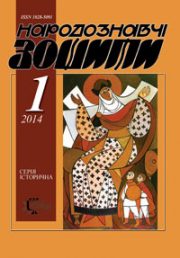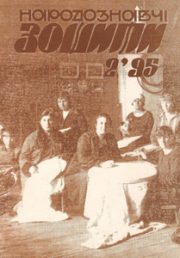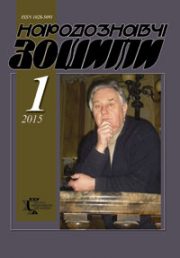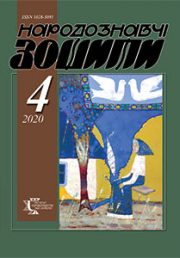The Ethnology Notebooks. 2023. № 4 (172), 1023—1038
UDK [76.046.3:27-526.62](477)”15/18″
DOI https://doi.org/10.15407/nz2023.04.1023
GRAPHIC ICONS FOR HOMES (EASEL SHEETS-ICONS, FOLK WOODCUTS, ENGRAVINGS PLACED UNDER PAINTED GLASS)
TRISKA Oksana
- ORCID ID: https://orcid.org/0000-0002-4717-4396
- Candidate of Art History (Ph.D.),
- senior researcher at Folk Art Department
- of Ethnology Institute of the National Academy of Sciences of Ukraine,
- 15, Svobody ave., 79000, Lviv, Ukraine,
- Contacts: e-mail: oksana_triska@yahoo.de
Abstract. Over the centuries, household icons have been a necessary attribute of Christian life. The method of implementing religious subjects depended on many factors, namely, the time of creation, prevailing artistic trends, the environment for which they were intended, and the availability of materials.
The purpose of the article is to systematize information about icons made graphically, as well as highlight various possibilities of their application. The object of research is the works of professional and folk engravers of the second half of XVI—XIX centuries. Territorial boundaries relate to Ukrainian ethnic lands, chronological boundaries to the specified time period with special attention to products of the 18th and 19th centuries.
The article uses the historical method as the main one in tracking the sequence of the development of the phenomenon, and the iconographic method — in order to determine the plots and understand the peculiarities of thematic repetitions. A significant part of the research was conducted on the basis of iconographic and comparative analysis. The novelty of the article lies in the comprehensive coverage of the functioning of the graphic icon as a separate genre of home icon painting.
Conclusions. Starting from the 17th century. sheet engravings were an affordable way of spreading religious subjects. The impetus for their replication was the appearance and development of book printing. Famous engravers created numerous prints depicting miraculous icons, individual saints or scenes from their lives. Along with the professional ones, there were folk masters who printed simplified versions of popular subjects. Small sheets with the image of Jesus, the Mother of God, and saints were given as gifts during prayers, and larger prints were sold at fairs, etc. For the sake of variety, woodcuts were often illuminated — in the XVII—XVIII centuries. somewhat monochrome, in the 19th century — more colorful. An important way of using prints as icons was their adaptation to wall mounting (fixation on a board, paper, placing under glass). Pasting on the board with subsequent painting of the plot and fields gave the «collage» a complete look of the icon.
Replication and distribution of graphic prints was a multifunctional phenomenon. In addition to domestic use in the form of icons, prints served as an iconographic and artistic basis for the development of folk iconography.
Keywords: sheet engraving, embossing, graphic print, folk icons-woodcuts, iconography, illuminated print.
Received 29.06.2023
REFERENCES
- Greshlyk, V. (2004). Church of the Ascension of the Lord in the village of Kozany near Bardiev. Western Ukrainian church art. Materials of the international scientific conference Lancut; Kotan, April 17—18, 2004 (Vol. II, pp. 319—320). Lancut [in Ukrainian].
- Aleksandrovych, V. (2008). Engraved icons from the collection of Volodymyr Vuytsyk in the funds of the Scientific Library of Ivan Franko Lviv National University. Visnyk Lviv. University (Issue 3. pp. 229—237) [in Ukrainian].
- Biletskyi, P. (1963). Ukrainian art of the XVII—XVIII centuries. Kyiv: Mystetstvo [in Ukrainian].
- Fomenko, V.M. (1976). Hryhoriy Levytskyi and Ukrainian engraving. Kyiv: Naukova dumka [in Ukrainian].
- Shpak, O. (2006). Ukrainian folk engraving of the 17th—19th centuries. Lviv: Institute of Ethnology of the National Academy of Sciences of Ukraine [in Ukrainian].
- Vyunyk, A. (1994). Ukrainian graphics of the 11th and early 20th centuries. Kyiv: Mystetstvo [in Ukrainian].
- Shpak, O. (2018). Folk engraving. Ecclesiastical art of Ukraine: in 3 vol. Fine art (Vol. 2, pp. 421—460). Kharkiv: Folio [in Ukrainian].
- (1897). The journey of the Patriarch of Antioch Macarius to Russia in the middle of the 17th century, described by his son Archdeacon Paul of Aleppo (Issue 2). Moscow [in Russian].
- Kielburger, I.F. Short report on Russian trade, how it was carried out throughout Russia in 1674. Retrieved from: www.history/syktnet/ru/01/06/012.html (date of access 02/03/2023) [in Russian].
- Bondar, N.P. (2005). To the history of book illustrations as independent stamp engravings at the end of the 16th and 17th centuries. Manuscript and book heritage of Ukraine (Vol. 10. pp. 212—231) [in Ukrainian].
- (1884). Sulymovsky archive. Kyiv [in Russian].
- Zayets, O.V. Collection of the Hieromonk of the Kyiv-Pechersk Lavra Dosypheus (Ivashchenko) as a source of knowledge. Church, science, society: issues of interaction. XIII International Scientific Conference, Kyiv, May 27—29, 2015) (Pp. 209—211) [in Ukrainian].
- Fomenko, V.M. (1973). Artistic values in the collection of the National Library in Warsaw. NTE, 3, 81—83 [in Ukrainian].
- Fomenko, V. (2002). Prints of the type of «folk pictures» in the system of Ukrainian artistic culture. IV Gonchariv readings: Traditional and personal in art (Pp. 354—366). Kyiv: Museum of Ivan Honchar [in Ukrainian].
- Shulika, P. (1862). Where he found, where he lost. Osnova (Vol. 4, p. 80).
- Sydor-Oshurkevich, O. (1994). Ukrainian anti-mine engraving of the 17th—18th centuries. Notes of the T. Shevchenko Scientific Society. Proceedings of the art history section (Vol. 227, pp. 171—182). Lviv [in Ukrainian].
- Fomenko, V.M. (1996). Early Kyiv engravings of the type of «folk pictures». NTE, 1, 6—13 [in Ukrainian].
- Stepovyk, D. (1975). Oleksandr Tarasevich. Kyiv: Mystetstvo [in Ukrainian].
- Adrug, A. Engraving boards of the Chernihiv printing house of the XVII—XVIII centuries. Siveryanskyi chasopys 15. Retrieved from:https://dspace.nbuv.gov.ua [in Ukrainian].
- Stepovyk, D.V. (1986). Leontiy Tarasevich and Ukrainian Baroque Art. Kyiv: Naukova dumka [in Ukrainian].
- Sydor, O. (2018). Graphics. Ecclesiastical art of Ukraine: in 3 vol. Fine art (Vol. 2, pp. 349—420). Kharkiv: Folio [in Ukrainian].
- Chuiko, O.D. (2006). The role of the rank of St. Basil the Great in the development of the cultural and artistic life of Western Ukraine in the 18th century. Bulletin of KhDADM, 12, 149—157 [in Ukrainian]
- Ohienko, I.I. (1994). History of Ukrainian printing. Kyiv: Lybid [in Ukrainian].
- Shpak, O. Pochaiv xylographic prints of the mid. of the 18th — early 19th centuries in Kyiv collections. Volyn icon: research and restoration. Proceedings of the X International Scientific Conference. Lutsk, September 17—19, 2003. Retrieved from: https://volart.com.ua [in Ukrainian].
- Bryzhuk, A. Coronation ceremony in the Pochayiv Monastery, 1773. Retrieved from: https://ostrohcastle.com.ua/tseremoniya-koronatsiyi-v-pochayivskomu-monastyri-1773-r/ (access date 06/16/2023) [in Ukrainian].
- Stepovyk, D. (1983). The Lithuanian period of work of the engraver Ivan Shchyrsky. Ukrainian art in international relations (Pp. 74—84). Kyiv: Naukova dumka [in Ukrainian].
- Jacher-Tyszkowa, A. (1987). Woodworks from Lezajsk and their lineage. Polish Folk Art, 1—4, 47—58 [in Polish].
- Romaniv-Triska, O. (2008). Western Ukrainian painting on glass of the 19th — early 20th century. Folk icon on glass: album (Pp. 13—33). Kyiv: Institute of Collectors at the Shevchenko Scientific Society [in Ukrainian].
- Yefimchuk, N. On issues of the history of the book trade of the Kyiv-Pechersk Lavra in the second half of the 18th century. XIII international scientific conference «Church, science, society: issues of interaction», Kyiv, May 27—29, 2015) (Pp. 207—209) [in Ukrainian].
- Pylypenko, B. (1925). Woodcuts of the Chernihiv State Museum. Chernihiv [in Ukrainian].
- E-exhibition. Folk woodcuts from Plaziv. Retrieved from: https://drzeworyty.eu/kolekcja2/#book5/page1 (access date 21/06/2023) [in Ukrainian].
- Shpak, O.D. (2004). Ukrainian folk engravings from the village of Plaziv. Notes of the Shevchenko Scientific Society. Proceedings of the Fine and Applied Arts Commission (Vol. SSHLVIIII (248), pp. 396—406). Lviv [in Ukrainian].







